Clean your soap making molds effectively with these five simple methods. Start with hot water and mild detergent for basic cleaning, or try natural solutions like baking soda and vinegar for stubborn residues. You can use rubbing alcohol to remove lingering fragrances, while denture tablets offer a non-toxic cleaning option. For wooden molds, apply mineral oil to prevent warping. Deep cleaning with a lye solution tackles the toughest buildup – discover the detailed steps below.
Hot Water and Detergent Method
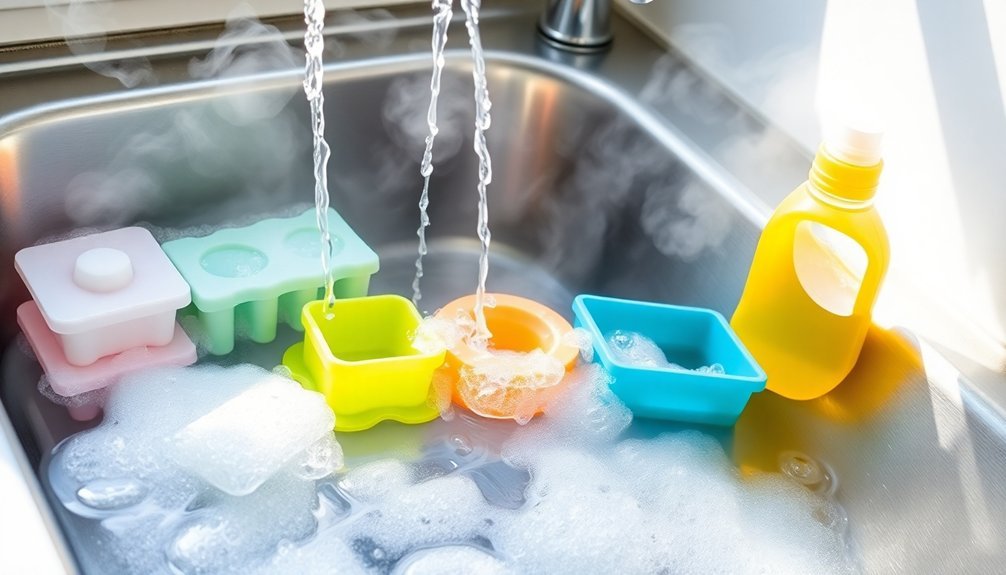
The hot water and detergent method is a straightforward way to maintain your soap making molds. You'll need to clean them right after use with hot water and mild detergent to prevent residue buildup that can lead to rancidity.
Keep soap molds clean by washing immediately with hot water and mild detergent to prevent residue buildup and rancidity issues.
Start by letting your molds soak in a mixture of hot water and detergent for several minutes. This will help dissolve any soap residue and oils that are clinging to the surface.
Next, thoroughly rinse the molds under hot running water until you've removed all traces of soap and detergent. If you're dealing with stubborn residues, don't hesitate to repeat the washing process or use a gentle scrub pad to remove remaining particles.
Finally, let your molds air dry completely before storing them to prevent moisture-related issues.
Natural Cleaning Solutions
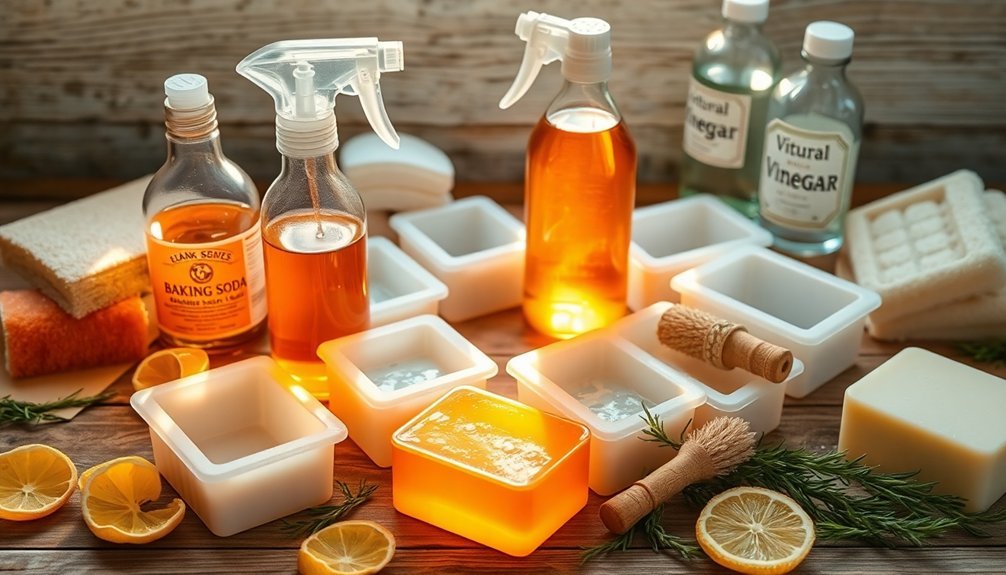
Natural alternatives provide effective and eco-friendly ways to clean your soap making molds without harsh chemicals.
You can start by soaking molds in warm water with a few drops of dish soap to loosen soap residue. For stubborn stains, mix baking soda and vinegar to create a gentle abrasive that fizzes away residues.
Rubbing alcohol works as a natural solution for removing fragrance and essential oils from your molds.
If you're dealing with particularly tough stains, dissolve denture tablets in water to create a non-toxic cleaning solution that won't damage your molds.
After cleaning, place your molds in direct sunlight to naturally eliminate any remaining scents.
These simple techniques guarantee your molds stay clean and fresh while maintaining their integrity for future soap-making projects.
Specialized Mold Care Techniques
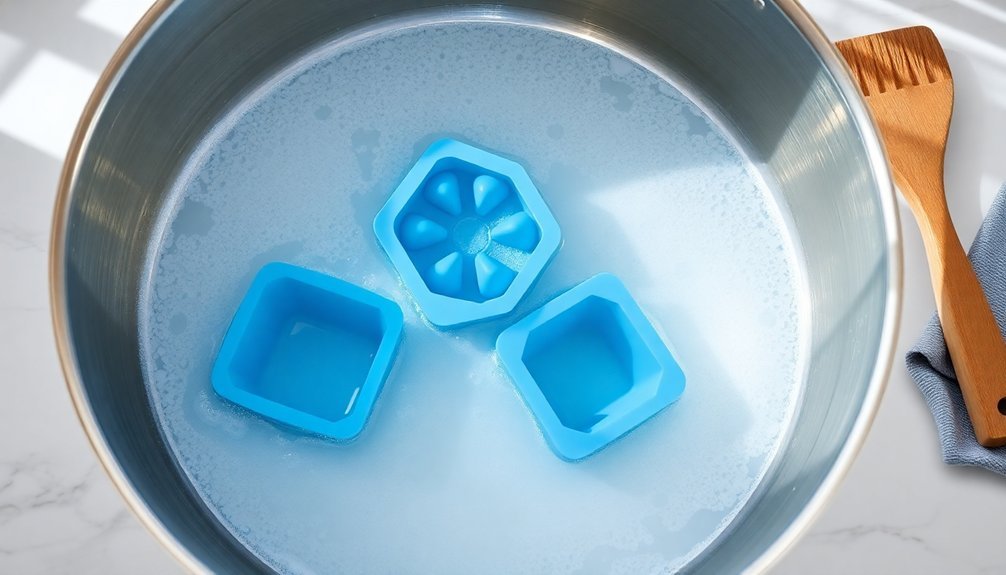
Proper maintenance of specialized soap molds requires specific care techniques to extend their lifespan and guarantee consistent results. You'll need to apply a thin layer of lanolin or Vaseline as a release agent before using silicone molds. For high-quality molds, implement a dedicated cleaning method by soaking them in dilute hot lye water to break down soap residues.
| Mold Type | Care Technique | Issue | Solution |
|---|---|---|---|
| Silicone | Release Agent | Sticking | Lanolin/Vaseline |
| Silicone | Alcohol Wipe | Stubborn Dye | Rubbing Alcohol |
| Wood | Oil Treatment | Warping | Mineral Oil |
| Both | Inspection | Wear and Tear | Regular Checks |
Don't forget to check your molds regularly for damage. For wood molds, apply mineral oil periodically to prevent warping, and never soak them in water.
Quick-Clean Maintenance Steps
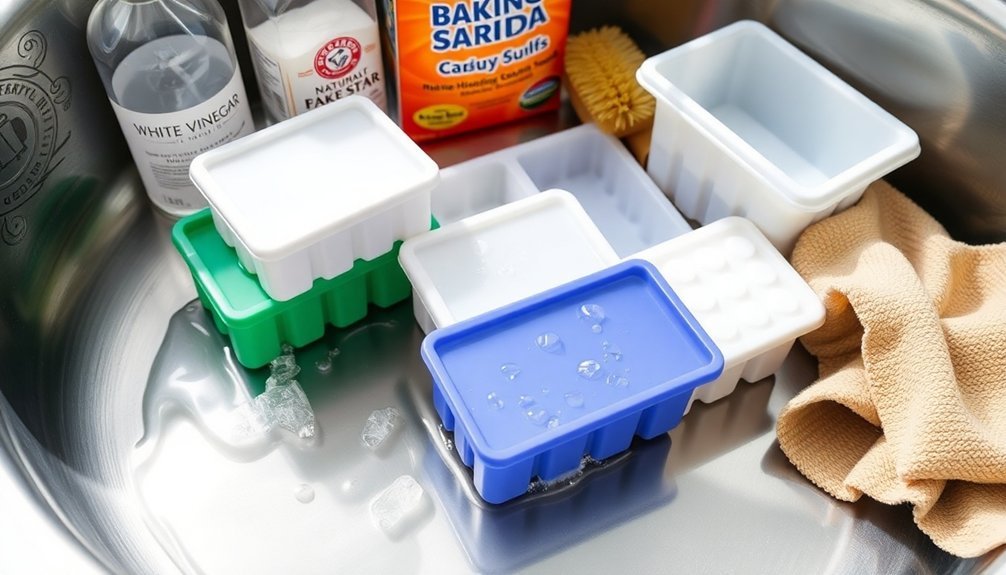
When making soap regularly, maintaining a quick and efficient cleaning routine for your molds will prevent long-term damage and secure consistent results.
After use, wash your soap making molds with warm soapy water immediately. For stubborn soap residue, mix hot water with sodium hydroxide and soak the molds before gently scrubbing with a soft brush.
- Don't let soap residue buildup ruin your beautiful creations – rinse molds thoroughly under hot water
- Eliminate lingering fragrances that could affect your next batch by wiping with rubbing alcohol
- Protect your investment by storing molds in a clean dry place after they're completely dry
This simple maintenance routine guarantees your molds remain in perfect condition for your next soap-making session, saving you time and money while preserving the quality of your handmade soaps.
Deep Cleaning for Stubborn Residue
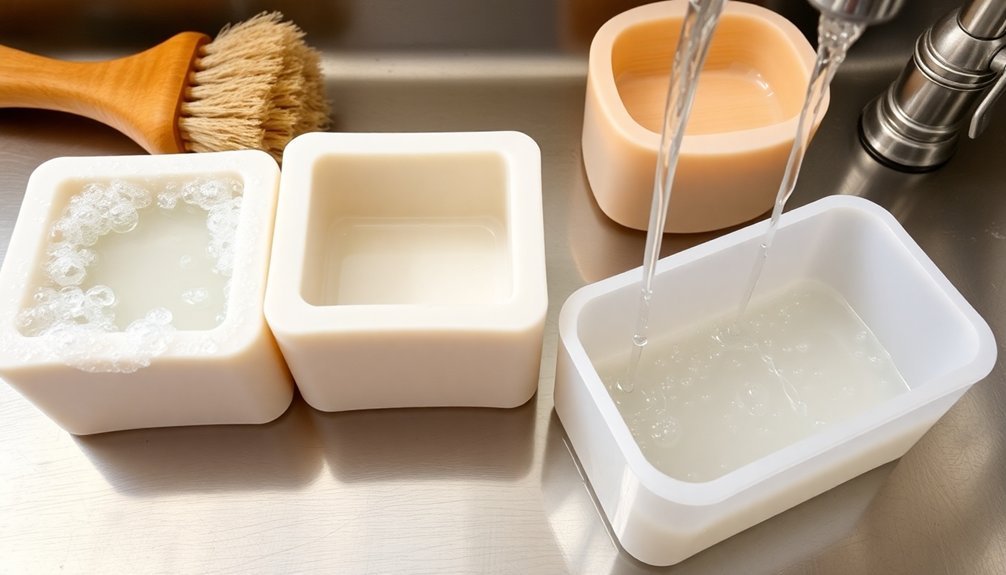
Despite regular maintenance, soap molds can develop stubborn residues that require deeper cleaning methods. For the most effective deep cleaning, you'll need to soak your molds in hot lye solution, followed by thorough hot water rinses.
| Method | Application |
|---|---|
| Lye Solution | 1 tbsp sodium hydroxide per bowl of hot water, soak 15-30 mins |
| Hot Rinse | Run under hot water to remove dissolved residue |
| Rubbing Alcohol | Wipe with alcohol-soaked towel, let sit briefly |
| Stain Treatment | Apply baking soda and vinegar mixture to affected areas |
| Inspection | Check for buildup after cleaning, repeat if needed |
When dealing with persistent stains or scents, use rubbing alcohol on a kitchen towel and let it sit. For tough dye stains, apply a mixture of vinegar and baking soda. Remember to inspect your molds regularly and perform deep cleaning every few uses to maintain ideal condition.
Frequently Asked Questions
How to Clean Soap Mold?
You'll need to wash your molds with warm soapy water right after use. For tough residue, soak in dilute hot lye solution. Use rubbing alcohol for stubborn scents, and store them flat when dry.
How to Clean up After Soap Making?
Clean up while soap's still warm. Use warm soapy water to scrub your equipment, wipe down surfaces with paper towels, and rinse thoroughly with rubbing alcohol. Don't forget to inspect everything for residue before storing.
What Is the Best Way to Clean Silicone Molds?
You'll want to wash your silicone molds with warm, soapy water right after use. For tough residue, soak them in diluted hot lye water, then rinse thoroughly. Finally, wipe with rubbing alcohol for extra cleanliness.
Do You Need to Grease Soap Molds?
You don't need to grease silicone molds, as they're naturally non-stick. However, if you're using wooden molds, apply a thin layer of lanolin or Vaseline to prevent sticking and guarantee easy removal.
In Summary
You've now learned five effective methods to keep your soap making molds in pristine condition. Whether you're using hot water and detergent, natural solutions, or specialized techniques, regular cleaning will extend your molds' lifespan and guarantee quality soap production. Don't forget to incorporate quick maintenance into your routine and tackle stubborn residue with deep cleaning when needed. With these methods, you'll have spotless molds ready for your next batch.

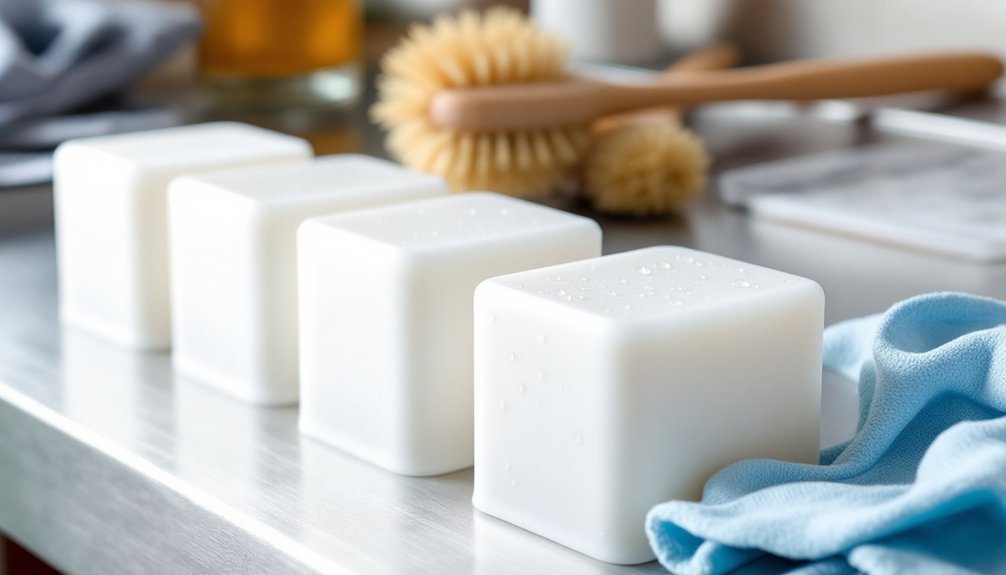



Leave a Reply